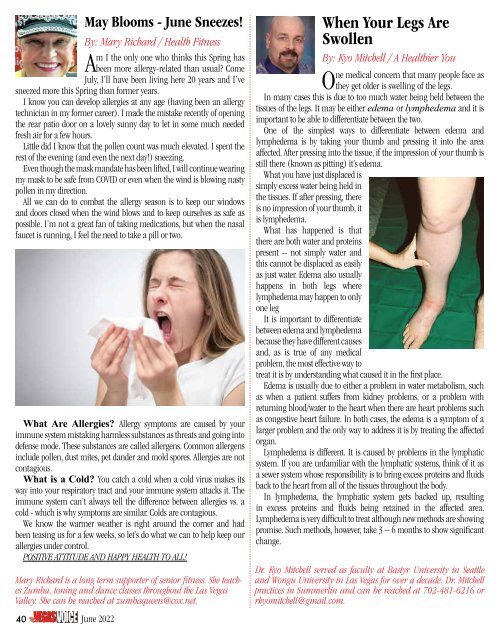You also want an ePaper? Increase the reach of your titles
YUMPU automatically turns print PDFs into web optimized ePapers that Google loves.
By: Mary Richard / Health Fitness<br />
Am I the only one who thinks this Spring has<br />
been more allergy-related than usual? Come<br />
July, I’ll have been living here 20 years and I’ve<br />
sneezed more this Spring than former years.<br />
I know you can develop allergies at any age (having been an allergy<br />
technician in my former career). I made the mistake recently of opening<br />
the rear patio door on a lovely sunny day to let in some much needed<br />
fresh air for a few hours.<br />
Little did I know that the pollen count was much elevated. I spent the<br />
rest of the evening (and even the next day!) sneezing.<br />
Even though the mask mandate has been lifted, I will continue wearing<br />
my mask to be safe from COVID or even when the wind is blowing nasty<br />
pollen in my direction.<br />
All we can do to combat the allergy season is to keep our windows<br />
and doors closed when the wind blows and to keep ourselves as safe as<br />
possible. I’m not a great fan of taking medications, but when the nasal<br />
faucet is running, I feel the need to take a pill or two.<br />
What Are Allergies? Allergy symptoms are caused by your<br />
immune system mistaking harmless substances as threats and going into<br />
defense mode. These substances are called allergens. Common allergens<br />
include pollen, dust mites, pet dander and mold spores. Allergies are not<br />
contagious.<br />
What is a Cold? You catch a cold when a cold virus makes its<br />
way into your respiratory tract and your immune system attacks it. The<br />
immune system can’t always tell the difference between allergies vs. a<br />
cold - which is why symptoms are similar. Colds are contagious.<br />
We know the warmer weather is right around the corner and had<br />
been teasing us for a few weeks, so let’s do what we can to help keep our<br />
allergies under control.<br />
POSITIVE ATTITUDE AND HAPPY HEALTH TO ALL!<br />
40 June 20<strong>22</strong><br />
May Blooms - June Sneezes!<br />
Mary Richard is a long term supporter of senior fitness. She teaches<br />
Zumba, toning and dance classes throughout the Las Vegas<br />
Valley. She can be reached at zumbaqueen@cox.net.<br />
When Your Legs Are<br />
Swollen<br />
By: Kyo Mitchell / A Healthier You<br />
One medical concern that many people face as<br />
they get older is swelling of the legs.<br />
In many cases this is due to too much water being held between the<br />
tissues of the legs. It may be either edema or lymphedema and it is<br />
important to be able to differentiate between the two.<br />
One of the simplest ways to differentiate between edema and<br />
lymphedema is by taking your thumb and pressing it into the area<br />
affected. After pressing into the tissue, if the impression of your thumb is<br />
still there (known as pitting) it’s edema.<br />
What you have just displaced is<br />
simply excess water being held in<br />
the tissues. If after pressing, there<br />
is no impression of your thumb, it<br />
is lymphedema.<br />
What has happened is that<br />
there are both water and proteins<br />
present – not simply water and<br />
this cannot be displaced as easily<br />
as just water. Edema also usually<br />
happens in both legs where<br />
lymphedema may happen to only<br />
one leg<br />
It is important to differentiate<br />
between edema and lymphedema<br />
because they have different causes<br />
and, as is true of any medical<br />
problem, the most effective way to<br />
treat it is by understanding what caused it in the first place.<br />
Edema is usually due to either a problem in water metabolism, such<br />
as when a patient suffers from kidney problems, or a problem with<br />
returning blood/water to the heart when there are heart problems such<br />
as congestive heart failure. In both cases, the edema is a symptom of a<br />
larger problem and the only way to address it is by treating the affected<br />
organ.<br />
Lymphedema is different. It is caused by problems in the lymphatic<br />
system. If you are unfamiliar with the lymphatic systems, think of it as<br />
a sewer system whose responsibility is to bring excess proteins and fluids<br />
back to the heart from all of the tissues throughout the body.<br />
In lymphedema, the lymphatic system gets backed up, resulting<br />
in excess proteins and fluids being retained in the affected area.<br />
Lymphedema is very difficult to treat although new methods are showing<br />
promise. Such methods, however, take 3 – 6 months to show significant<br />
change.<br />
Dr. Kyo Mitchell served as faculty at Bastyr University in Seattle<br />
and Wongu University in Las Vegas for over a decade. Dr. Mitchell<br />
practices in Summerlin and can be reached at 702-481-6216 or<br />
rkyomitchell@gmail.com.

















